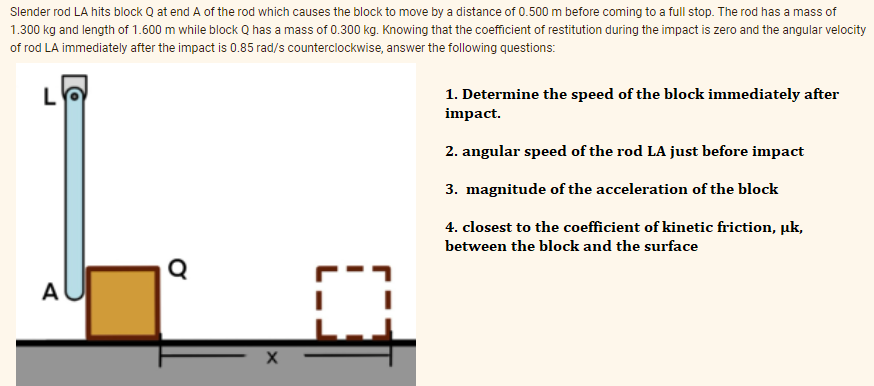Slender rod LA hits block Q at end A of the rod which causes the block to move by a distance of 0.500 m before coming to a full stop. The rod has a mass of 1.300 kg and length of 1.600 m while block Q has a mass of 0.300 kg. Knowing that the coefficient of restitution during the impact is zero and the angular velocity of rod LA immediately after the impact is 0.85 rad/s counterclockwise, answer the following questions: L 1. Determine the speed of the block immediately after impact. 2. angular speed of the rod LA just before impact 3. magnitude of the acceleration of the block 4. closest to the coefficient of kinetic friction, uk, between the block and the surface A C x-
Slender rod LA hits block Q at end A of the rod which causes the block to move by a distance of 0.500 m before coming to a full stop. The rod has a mass of 1.300 kg and length of 1.600 m while block Q has a mass of 0.300 kg. Knowing that the coefficient of restitution during the impact is zero and the angular velocity of rod LA immediately after the impact is 0.85 rad/s counterclockwise, answer the following questions: L 1. Determine the speed of the block immediately after impact. 2. angular speed of the rod LA just before impact 3. magnitude of the acceleration of the block 4. closest to the coefficient of kinetic friction, uk, between the block and the surface A C x-
Elements Of Electromagnetics
7th Edition
ISBN:9780190698614
Author:Sadiku, Matthew N. O.
Publisher:Sadiku, Matthew N. O.
ChapterMA: Math Assessment
Section: Chapter Questions
Problem 1.1MA
Related questions
Question
100%

Transcribed Image Text:Slender rod LA hits block Q at end A of the rod which causes the block to move by a distance of 0.500 m before coming to a full stop. The rod has a mass of
1.300 kg and length of 1.600 m while block Q has a mass of 0.300 kg. Knowing that the coefficient of restitution during the impact is zero and the angular velocity
of rod LA immediately after the impact is 0.85 rad/s counterclockwise, answer the following questions:
L
1. Determine the speed of the block immediately after
impact.
2. angular speed of the rod LA just before impact
3. magnitude of the acceleration of the block
4. closest to the coefficient of kinetic friction, uk,
between the block and the surface
A
X
Expert Solution
This question has been solved!
Explore an expertly crafted, step-by-step solution for a thorough understanding of key concepts.
This is a popular solution!
Trending now
This is a popular solution!
Step by step
Solved in 4 steps with 4 images

Knowledge Booster
Learn more about
Need a deep-dive on the concept behind this application? Look no further. Learn more about this topic, mechanical-engineering and related others by exploring similar questions and additional content below.Recommended textbooks for you

Elements Of Electromagnetics
Mechanical Engineering
ISBN:
9780190698614
Author:
Sadiku, Matthew N. O.
Publisher:
Oxford University Press

Mechanics of Materials (10th Edition)
Mechanical Engineering
ISBN:
9780134319650
Author:
Russell C. Hibbeler
Publisher:
PEARSON

Thermodynamics: An Engineering Approach
Mechanical Engineering
ISBN:
9781259822674
Author:
Yunus A. Cengel Dr., Michael A. Boles
Publisher:
McGraw-Hill Education

Elements Of Electromagnetics
Mechanical Engineering
ISBN:
9780190698614
Author:
Sadiku, Matthew N. O.
Publisher:
Oxford University Press

Mechanics of Materials (10th Edition)
Mechanical Engineering
ISBN:
9780134319650
Author:
Russell C. Hibbeler
Publisher:
PEARSON

Thermodynamics: An Engineering Approach
Mechanical Engineering
ISBN:
9781259822674
Author:
Yunus A. Cengel Dr., Michael A. Boles
Publisher:
McGraw-Hill Education

Control Systems Engineering
Mechanical Engineering
ISBN:
9781118170519
Author:
Norman S. Nise
Publisher:
WILEY

Mechanics of Materials (MindTap Course List)
Mechanical Engineering
ISBN:
9781337093347
Author:
Barry J. Goodno, James M. Gere
Publisher:
Cengage Learning

Engineering Mechanics: Statics
Mechanical Engineering
ISBN:
9781118807330
Author:
James L. Meriam, L. G. Kraige, J. N. Bolton
Publisher:
WILEY